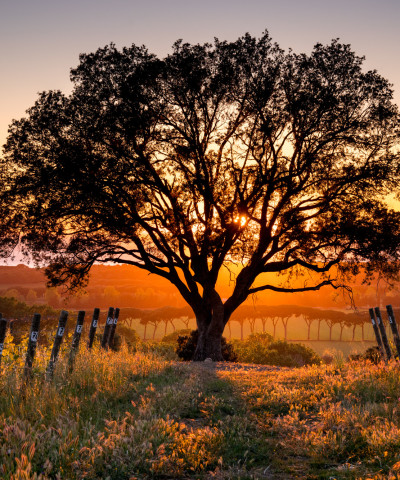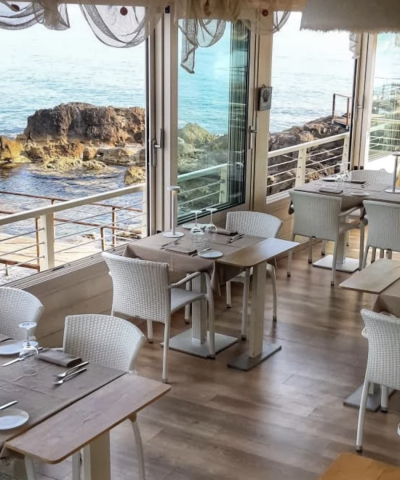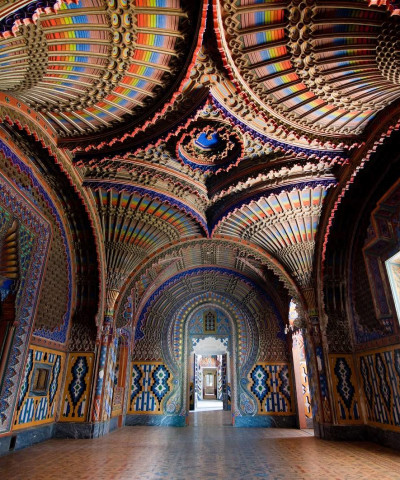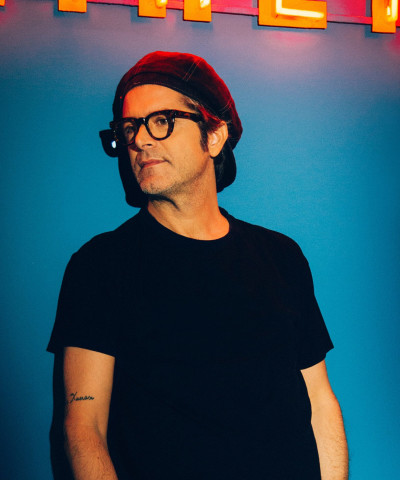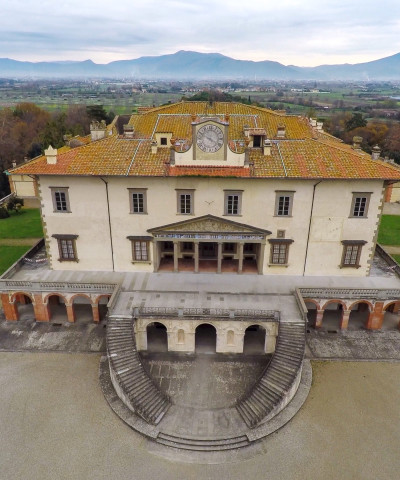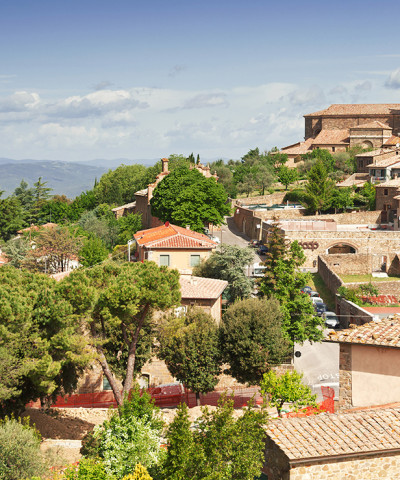FAI Autumn Days: 12 and 13 October 2024 in Tuscany
All open places in Tuscany on 12 and 13 October
Saturday 15 and Sunday 16 October 2022 sees the return of the "FAI Autumn Days", the major autumn event dedicated by the FAI to Italy's cultural heritage and landscape. Among the many places open in all regions there will be palaces, villas, churches, castles, archaeological areas, museums, military sites, examples of industrial archaeology, places of education and research centres. Let's discover together the places not to be missed in Tuscany.
AREZZO
Vasari at Arezzo
Giorgio Vasari, art historian and writer, worked for the Medici family during the late Renaissance period (he designed the famous Vasari Corridor, located in the historic centre of Florence, for the family). The route, aimed at discovering this character, will consist of three stages: Palazzo delle Logge, Teatro Vasariano and Fraternita dei Laici. The palace's loggias overlook the Piazza Grande, creating a frame. In the centre is a flight of steps, leading to the second stop on the tour: the Teatro Vasariano. Built between 1580 and 1586, it was initially part of a larger project in which Vasari wanted to build dwellings and public spaces. On the last stop, visitors can visit the Palazzo Fraternita dei Laici, the former seat of the Istruzione Aretina. Inside the palace, it will be possible to visit the exhibition ‘Honorato e Gratiosa’, through which it will be possible to discover the project and the laories behind the construction of the Vasari Loggias. The visit is open to the public on Saturday from 3 to 5 p.m. and on Sunday from 10 a.m. to noon and then from 3 to 5 p.m.
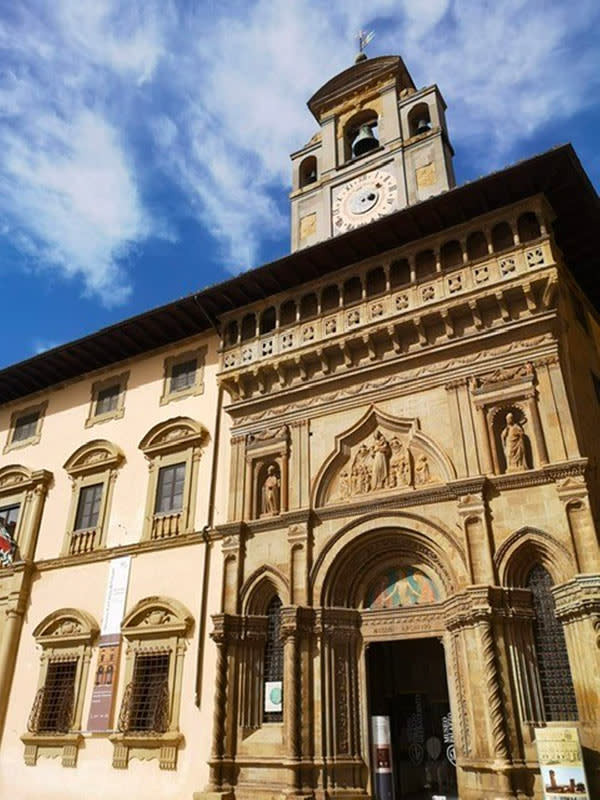 Portico del Vasari in piazza Grande
Portico del Vasari in piazza GrandeFIRENZE
Church of Santa Maria di Candeli
Founded in the 13th century in the Santa Croce district, the former monastery of Santa Maria di Candeli is now the headquarters of the Tuscan Carbinieri Legion. The complex was considerably enlarged between the 16th and 18th centuries and during the 19th century it became the seat of education, housing the military high school; only in 1864 did it become the headquarters of the territorial command of the Carabinieri. The complex houses frescoes attributed to Giovanni Antonio Sogliani, painted between 1510 and 1514. The pictorial decoration was instead carried out by Stefano Papi, Giovan Battista Ciceri, Giuseppe Tonelli and Niccolò Francesco Lapi. The opening is dedicated to FAI members (you can register on site), Saturday from 10 a.m. to 5 p.m. and Sunday from 12.30 p.m. to 5 p.m.
Oratory of Jesus Pilgrim - Pretoni
The oratory was founded in 1313 under the name of San Salvatore. It was suppressed in 1785 and, at the end of the following century, became state property, thanks to which it underwent numerous modifications and restorations. Today it is the study hall of the Academy of Fine Arts. Visitors can admire the walls frescoed by Bastiano Balducci, known as Cosci, depicting the last apparitions of Christ and the apostles. Entrance to the oratory is open to FAI members, Saturday and Sunday from 10 a.m. to 5 p.m.
Military Chemical-Pharmaceutical Plant
In the area of Castello, north of Florence, is the Stabilimento Chimico Farmaceutico Militare, built during the expansion of the city between the 1960s and 1970s. The origin of the institute is in Turin, where it was built in 1853 for the production of drugs for the armed forces and was transferred to Florence in 1931. During the Second World War it was destroyed, but thanks to the expansion of its mission, no longer only military, the complex had a remarkable revival. Inside the building it will be possible to visit the laboratories and the courtyard.
Villa Schifanoia
In the hills of Fiesole stands the Villa Schifanoia. Initially a simple farmhouse, it passed into the hands of the Cresci family in the 15th century, who transformed it into an elegant country residence. After being purchased in 1927 by the American tycoon Myron Taylor, thanks to whom the villa was restored. Taylor later donated it to Pope Pius XII and in 1986 it was purchased by the Italian State, becoming one of the headquarters of the European University Institute. The name derives from the expression ‘dodging boredom’, in fact the villa was a place of leisure. Characteristic are the Italian-style gardens, spread over three levels. They are overlooked by the terrace on the second floor, which is connected to the gardens by two staircases. Visitors will be guided through the gardens, the chapel and the inner rooms; included in the tour will be the former library and the main hall, which are usually closed to the public. Opening to the public will be on Saturday and Sunday from 10 a.m. to 5 p.m.
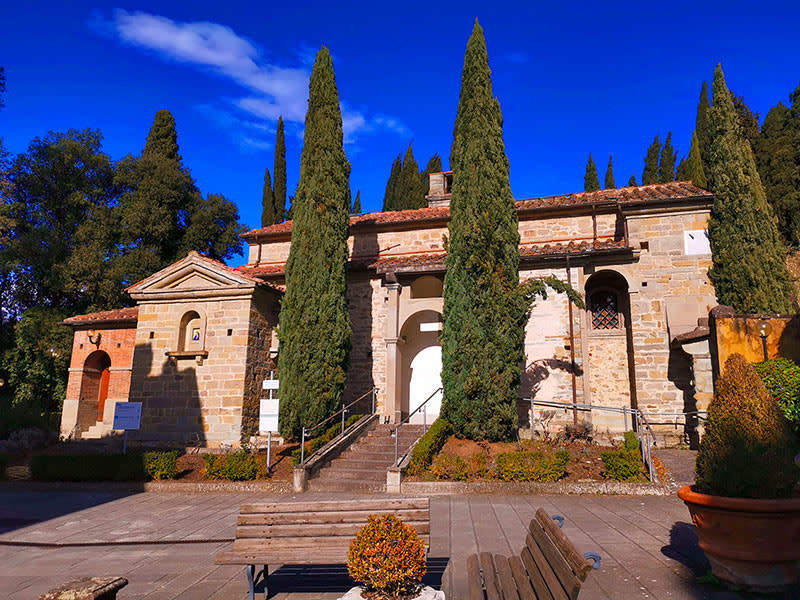 Villa Schifanoia
Villa SchifanoiaGROSSETO
Gavorrano
On the metalliferous hills of the Maremma stands the town of Gavorrano. Its origins date back to the year 1000, when the people of the plains decided to climb the slopes of Monte Calvo to escape pirate raids. In 1164 Gavorrano was mentioned for the first time as a ‘castle’, shortly afterwards it passed into the hands of the Alberti family of Mangona, in which it remained until the middle of the 13th century in the hands of the Pannocchieschi family, linked to mining activities. In 1331 it was conquered by Siena and around 1550 was annexed to the Florentine Republic. Towards the end of the 19th century, a pyrite deposit was discovered near the castle and a mine was created, which remained active until 1984. The tour develops in the village, through which guides will show the life of the miners and the hard work they did. It will also be possible to visit the Palazzo Comunale and the Church of San Giuliano. Those registered with the FAI will be able to enter Palazzo Salvucci, where the heirs of the family will be guided. The entrance is open on Saturday and Sunday from 10 a.m. to 4 p.m.
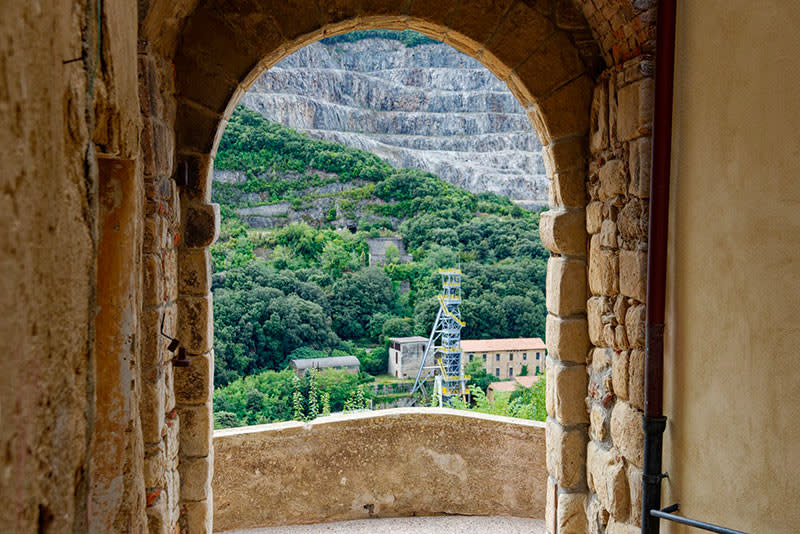 Gavorrano
GavorranoLIVORNO
Rosignano Castle
In the province of Livorno, facing the sea, is the village of Rosignano Marittimo. The village was built around 1100, but the original centre certainly has older origins, probably Roman or Etruscan. The castle is absolutely the star of this complex of buildings. Here, visitors will be guided through the streets of the village, visiting churches and scenic views. The castle and Palazzo Bombardieri, home to the archaeological museum, will also be visited. Visitors can enter on Saturday from 3 to 6 p.m. and on Sunday from 10 a.m. to 6 p.m.
The port of vada
In Etruscan and Roman times, the port of Volterra was located at Vada, between the mouths of the Fine and Cecina rivers. The port, which housed docks and manufacturing centres, was fundamental for transporting goods from Volterra to the sea and vice versa, but it also had the function of supplying water to the Great and Small Baths. The port remained active until the 7th century A.D., as evidenced by the nearby necropolis and dwellings. Visitors, (only FAI members can participate, you can register on site) will be able to walk around the site accompanied by archaeologists from the University of Pisa, in fact the excavation is not open to the normal public, due to ongoing research.
LUCCA
The Convent of St Francis, Borgo a Mozzano
20 km from Lucca, the Franciscan Convent of Borgo a Mozzano opens its doors to the public to celebrate its 500th anniversary. The convent was founded by the Franciscan Friars Minor and remained in use until the end of the last century. Today the convent is the active centre of voluntary work and culture. Visitors will be able to admire the frescoed cloister, painted by Domenico Manfredi da Camaiore, as well as the interior of the church, where they will be accompanied by the music of the 18th-century organ, and the monastery's inner rooms. FAI members will also have access to the library, which houses the monastery's music archive and ancient volumes. Visits will be held on Saturday and Sunday from 10 a.m. to 1 p.m. and then from 2 p.m. to 5.30 p.m.
Lake della Gherardesca, Capannori
The Gherardesca Lake extends over no less than 30 hectares in the Compitese hills. It is a nature reserve characterised by various species of fauna and flora, and is also considered a natural heritage to be preserved; in fact, it lies on the routes of many migratory birds, which are used to stopping to rest in its waters. The absolute protagonists are the reed beds, which offer shelter to small water birds and some fish species. Originally Lago della Gherardesca was called Lago di Bientina and extended over 40 square kilometres, but in the 19th century the marshland was reclaimed for the construction of agricultural fields (which are still irrigated today thanks to the lake's waters). The guided tour will allow you to immerse yourself in the nature of the lake and learn about its peculiarities. Visits are open Saturday and Sunday from 10 am to 12.30 pm and from 2.30 pm to 6.30 pm.
Martinelli Luce, Lucca
The design company opens to the public for the FAI days. Founded in the 1950s by Elio Martinelli, the company became an excellence in the field of lighting, thanks to Elio's genius and collaboration with important designers of the last century, who made Martinelli lamps emblematic. Visitors will be guided by architect Emilia Martinelli and FAI volunteers on an immersive tour, Saturday and Sunday from 10 a.m. to 12.30 p.m. and from 2 p.m. to 5.30 p.m.
Palazzo Guinigi, Lucca
Within the walls of Lucca stands the Palazzo Guinigi, whose arboreal tower is the symbol of the city. The palace was built in the 14th century and was owned by the Guinigi family until 1400, when the plague decimated their heirs, allowing the lord of Lucca to take possession of it. The palace returned to the family in 1588 and was donated to the municipality shortly afterwards. The visit includes an itinerary through the rooms of the palazzo and the garden, while the Altana will be exclusive to FAI members. The palace will be open to visitors on Saturday and Sunday from 10 a.m. to 12.30 p.m. and from 2 p.m. to 5.30 p.m.
Olive Tree Theatre, Camaiore
In the province of Lucca, in the municipality of Camaiore, stands the Theatre of the Olive Tree. The theatre, located in a 16th-century building that had fallen into disuse and was taken over in 1649, was officially established in 1772. During the Second World War, the theatre suffered damage, in fact it was closed for works and was only reopened to citizens in 2003. Access to the theatre will be possible on Saturday and Sunday from 10:30 to 12:30 and from 15:00 to 18:30. Visitors to the theatre on Saturday will be guided by students from the Marconi High School.
Theatre of Vetriano, Pescaglia
Its history dates back to 1889, when engineer Virgilio Biagini gave the small community a barn to be used as a theatre. The inhabitants, mostly peasants, warmly welcomed the donation and set up a ‘Società Paesana’, which self-taxed with a one-off payment of 2 lire and then 50 cents a month to build the theatre plus labour. Thanks to the industriousness of the inhabitants, the theatre was built in just one year and in 1890 the stage, framed by neo-classical decorations, could host the first performances. These were mostly prose plays and musical comedies. Guided tour Saturday from 2 to 6 p.m. and Sunday from 11.30 a.m. to 1.30 p.m. and 2 to 6 p.m.
MASSA
La centrale idroelettrica di Teglia, Pontremoli
La centrale idroelettrica, costruita negli anni '30 dalla S.A. Acciaierie e Ferrerie Lombarde Falck, ha il compito di raccogliere le acque dei torrenti Magriola, Verde, Bettigna, Pilacca, Lanza, Gordana, Marziola e Mezzemola. La centrale è suddivisa in un due grandi zone, la prima sulla riva sinistra del torrente Teglia, mentre la seconda si trova alla base di un pozzo, che raccoglie gli scarichi della prima. Accanto alla centrale si trova una stazione AT, in cui si trovano i trasformatori per la corrente prodotta dalla centrale. La visita vi porterà attraverso le condotte e il capannone, dal quale sarà possibile vedere la sala macchine. La centrale sarà visitabile solo nella giornata di sabato dalle 10 alle 13 e dalle 14 alle 18.
Palazzo Zucchi Castellini, Pontremoli
Il Palazzo, chiamato anche Ca' di Piazza, si trova nel centro storico di Pontremoli. Il palazzo risale al XVI secolo: l'edificio originario è caratterizzato da tratti rinascimentali, ma successivamente vennero inserite delle decorazioni barocche. La sua eleganza testimonia l'importanza culturale che questa cittadina ha detenuto durante il Rinascimento, quando Pontremoli faceva parte del Ducato di Milano. Durante la visita potrete immergervi nel vero stile barocco e rinascimentale, grazie all'eleganza dell'architettura, agli affreschi sulle pareti e gli arredi d'epoca. La visita al palazzo sarà possibile solo nella giornata di domenica dalle 10 alle 13 e dalle 15 alle 18.
PISA
Village of Pallaia
Pallaia is a village in the province of Pisa, of medieval origin, as witnessed by the Church of Sant'Andrea, built during the 13th century. The first certain news of the village dates back to the 10th century, when it passed from Lucca to Pisa and then to Florence in 1406. A visit through the village will allow you to discover the main buildings, such as the aforementioned Church of Sant'Andrea and the Piave di San Marino, built in pietra serena, also in 13th-century style. It will also be possible to visit the Palazzo Comunale with its gardens and the frescoes in the rooms (Sala della Giunta and Sala del Turco). Guided tours will be held on Sunday from 10 a.m. to 7 p.m.
The San Paola a Ripa d'Arno Church and the Sant'Agata Chapel
The two religious buildings, located in the city of Pisa, stand on the left bank of the Tuscan river, not far from the Citadel. The church overlooks the square, whose name it bears, and from the gardens at the back it is possible to visit the chapel. The complex was built in the 9th century, was later enlarged in the 14th century, and was modified in the early 20th century by the Vallombrosian monks, who lived there from that time on. It is one of the most popular churches in Pisa, thanks to its basilica plan and 14th-century stained glass windows in Gothic style. Restoration work was carried out after World War II, thanks to which frescoes were discovered. Guided tours will be held on Saturday from 3 to 6 p.m.
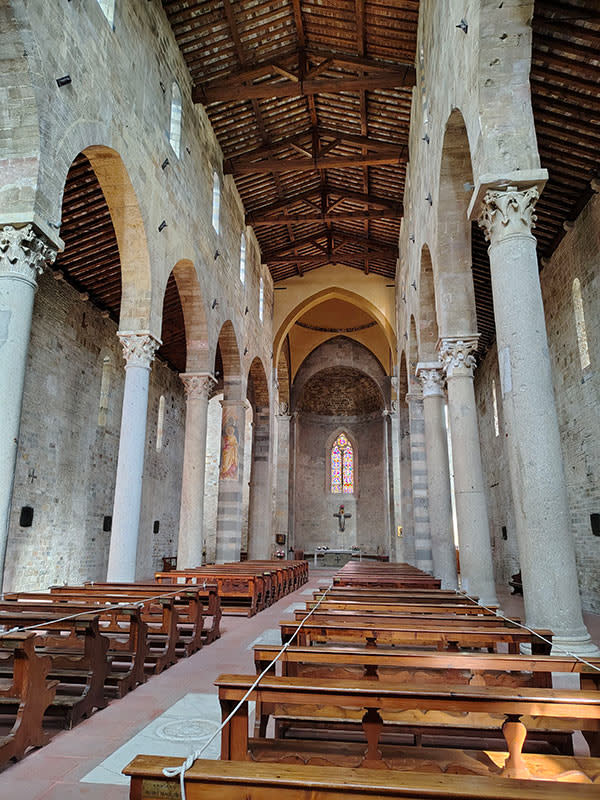 La chiesa San Paola a Ripa d'Arno e la cappella Sant'Agata
La chiesa San Paola a Ripa d'Arno e la cappella Sant'AgataPISTOIA
Chapel of the Holy Crucifix
In the historical centre of Pistoia is the Chapel of the Holy Crucifix. It was originally the monastery of the Benedictine nuns, who moved into the building in 1322. The first oratory was built in 1633, but it was destroyed, so in 1752 a new one was built, whose designs were entrusted to the Bottega degli Arrighi. The interior is decorated with paintings by Meucci and a sculptural group depicting God the Father, the dove, cherubs and angels. Loratory and monastery will be open to visitors on Saturday from 2 to 6.30 p.m. and on Sunday from 9 a.m. to 1 p.m. and from 2 to 6.30 p.m.
Church of St Mary of the Angels
Belonging to the Benedictine nuns since 1322, the Church of Santa Maria degli Angeli stands between Corso ANtonio Gramsci and Via dei Cancellieri. Thanks to a0ing a large sum, left to the nuns in a will, the church was completely renovated in 1590 and the high altar was created. The sandstone façade was realised in 1726 by Giovan Battista Foggini, thanks to the interest of Ferdinando de Medici, who decided to entrust the project of a new restoration to the Florentine architect. The walls of the building are decorated with elegant gilded frescoes in full Baroque style. The church can be visited on Saturdays and Sundays from 9am to 1pm and from 2pm to 6pm.
Banchieri Tolomei Palace
The Palazzo Banchieri Tolomei was the main seat of the Benedictine nuns of Santa Meria degli Angeli. Built in the mid-14th century, it was later abandoned by the nuns in the 18th century and was purchased by Pistoia bankers, who entrusted it to architect Stefano Ciardi, who carried out the restoration projects. In 1885 the Benedictine nuns took it back as their main residence and it is still inhabited by the nuns today. The guide will take place on the two floors of the building, which can be visited on Saturday from 2 to 6.30 pm and on Sunday from 9 am to 1 pm and from 2 to 6.30 pm.
Villa del Castellaccio, Uzzano
In the province of Pistoia, in the municipality of Uzzano, stands Villa del Castellaccio, built on the ruins of the previous fortress of Tobbiano. Due to its historical and cultural importance, in 191 the Villa was constrained by the Ministry of Education and in 2004 the constraint was reconfirmed. The structure of the Villa consists of the interior flats, which underwent various modifications between the 18th and 19th centuries, the Chapel, which is still consecrated today, and the garden, in which there is the circular pool in which Giacomo Puccini is said to have bathed. The guided tour of the villa will be open on Saturday and Sunday from 10 a.m. to 12.30 p.m. and from 3 p.m. to 6 p.m.
PRATO
Historical Centre
The historical centre of the city of Prato consists of the Cassero Medievale, the Bastione di Santa Chiara and the Convent of the same name. The Cassero was built in 1351. It was a 230-metre fortified road, which was used to allow Florentine soldiers to reach the castle from the outside in safety. Not far away is the 14th-century convent, whose walls are decorated with frescoes dating back to the mid-15th century. The church attached to the convent was renovated in the early 17th century and then restored at the end of the last century. The Bastion, named after the saint, was a fortification created on the city walls. The guided tour will start from the Cassero, then move on to the convent and finally to the Bastion, via a circular route. Visits will be held on Saturday and Sunday from 10 a.m. to 5 p.m.
Metastasio Theatre
In the historical centre, not far from the Palazzo Comunale, is the Metastasio Theatre. The theatre was built between 1828 and 1830 and became municipal property in 1930. The rather refined façade was built following the circular course of the street; the inner hall also has a semicircular shape and the vault bears frescoes by Antonio Marini. Renovation work began in 1956, commissioned by the then mayor Roberyo Giovannini, and was completed in 1964. Inside the theatre it is still possible to see performances and operas today. For the two FAI days, visits will be held on Saturday from 10 a.m. to 3.30 p.m. and on Sunday from 10 a.m. to 5 p.m.
SIENA
Campatelli Tower and House, San Gimignano
Of the 72 ancient towers that have made San Gimignano famous, only 14 have survived to this day to connote the unmistakable profile of Italy's most famous medieval town. Among these is that of the Campatelli, a family of Florentine entrepreneurs and landowners who from the early 19th century linked their name to this 28-metre tower-house erected in the mid-12th century, today the only one to have preserved the original single volume of the building, completely empty.
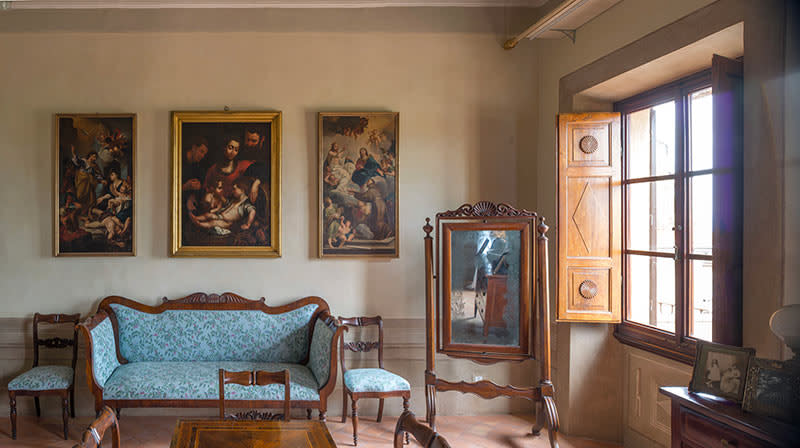 Torre e Casa Campatelli, San Gimignano
Torre e Casa Campatelli, San GimignanoFarnetella Castle, Sinalunga
Within the village of Farnetella stands the medieval castle. It initially had a defensive function, thanks to its elevated position, but was destroyed by Siena in the mid 13th century, as it had betrayed the city by harbouring Sienese fugitives. Shortly afterwards it was rebuilt further down the valley, in fact the original site took the name Castelvecchio. The rooms are decorated in typical Neo-Medieval style, with frescoes on the walls, mullioned and three-light windows. The dining room, as well as the main hall, was created in 1906 by Giovanni Samichelli, a famous Sienese carver. The castle, usually closed to the public, opens its doors during the FAI days. The rooms can be visited through a guided tour on Saturdays and Sundays from 10 a.m. to 4 p.m.
For some visits, reservations are required at www.giornatefai.it










